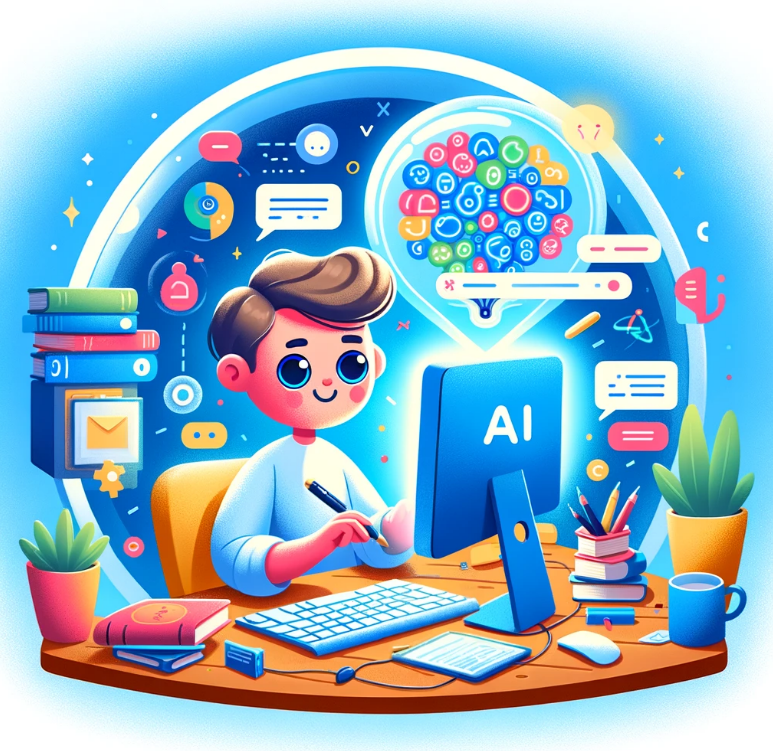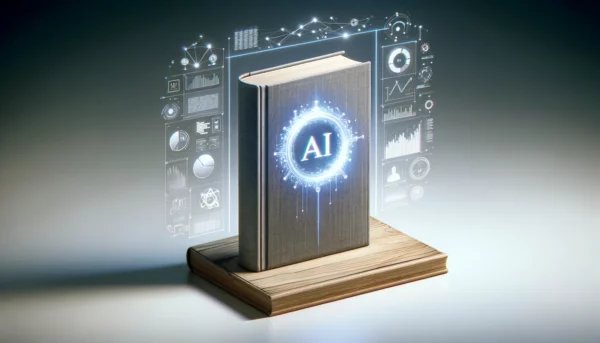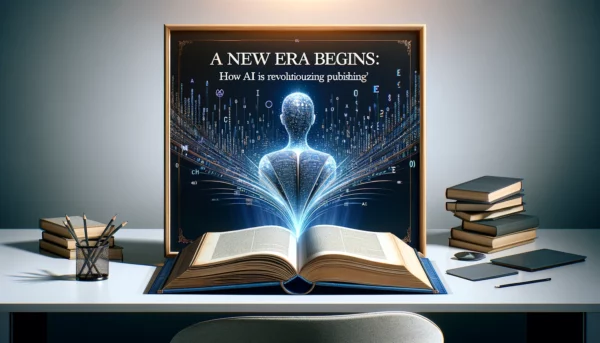The landscape of writing, an art form steeped in tradition and human emotion, has undergone a remarkable transformation in recent years. From the humble beginnings of quills and ink to the modern-day digital word processors, each advancement in writing technology has brought about its own revolution.
Today, we stand at the brink of another significant shift, brought forth by the advent of Artificial Intelligence (AI). AI tools for authors are not just emerging; they are rapidly reshaping the very fabric of how we write, think, and create content.
AI writing tools, a subset of this technological marvel, are software and applications that leverage AI algorithms to assist in various aspects of writing. From generating ideas to refining grammar, these tools are becoming indispensable for writers, journalists, novelists, and academic researchers alike.
This integration of AI into writing processes is not merely a trend but a full-fledged revolution, offering a unique blend of efficiency, creativity, and precision that was previously unattainable.
In this comprehensive exploration, we delve into the world of AI writing tools, unraveling how they function, the myriad benefits they offer, and the challenges they present. We will also explore the ethical implications of AI-generated content and forecast the future trajectory of these tools in the writing domain.
This article aims to provide an in-depth understanding of AI writing tools, offering a balanced perspective on how they are revolutionizing writing processes and, by extension, the landscape of literary creation.
Whether you are a skeptic or an enthusiast, a seasoned author or a novice writer, this article promises insights into how AI is redefining the rules of writing and opening new horizons for authors worldwide.

The Emergence of AI Tools for Authors
The journey from typewriters to AI writing tools encapsulates the evolution of writing technology over the centuries. This evolution has been marked by a constant endeavor to simplify the writing process and enhance the quality of written content.
Your Publishing Journey Awaits – Start NowHistorical Context: From Typewriters to Word Processors to AI Tools
The invention of the typewriter in the late 19th century revolutionized writing by mechanizing the process of creating documents. This was followed by the advent of word processors in the 20th century, which digitized writing, offering features like spell check and text formatting, further easing the writing process.
However, the latest leap in this evolutionary trajectory is the emergence of AI writing tools. These tools represent a paradigm shift from merely assisting in writing to actively participating in the content creation process itself.
Definition and Explanation of AI Writing Tools
AI writing tools are software programs that use artificial intelligence to assist with various aspects of the writing process. This assistance ranges from generating ideas and suggesting content to correcting grammar and refining style.
At the heart of these tools are complex algorithms and machine learning models that analyze vast amounts of data to understand and mimic human language patterns.
These tools work by processing the input given by the user and generating relevant output based on learned patterns. For instance, if a writer needs help with crafting a story’s opening line, the AI tool can generate multiple suggestions based on the genre, tone, and context provided by the writer.
Overview of the Current Landscape of AI Writing Software
The current landscape of AI writing software is both diverse and dynamic. There are tools tailored for specific writing needs – from creative writing software that helps authors plot stories and develop characters, to academic writing tools that assist in organizing research and citing sources.
One significant category is predictive text software, which suggests the next words in a sentence, thereby speeding up the writing process. Grammar and style-enhancing software tools are also widely used, helping writers refine their language and adhere to stylistic guidelines.
Another burgeoning area is content generation tools, which can draft entire articles or reports based on a set of parameters. While these tools are efficient, they also raise questions about the authenticity and originality of AI-generated content, a topic that is currently a hotbed of ethical debate.
Moreover, some AI writing tools are now incorporating voice recognition features, allowing writers to dictate their content, which the software transcribes and edits. This feature is particularly beneficial for individuals who find typing cumbersome or have disabilities that make traditional writing challenging.
The landscape also includes platforms that combine multiple AI writing tools, offering a comprehensive suite of services to cover all aspects of the writing process. These platforms are becoming increasingly popular among professional writers and businesses for their efficiency and the high quality of content they help produce.
How AI Writing Tools Work
AI writing tools represent a significant technological advancement, blending the complexities of artificial intelligence (AI) and machine learning with the nuanced process of writing.
To understand how these tools function, it’s essential to grasp the basic principles of AI and machine learning in the context of writing, explore the various types of AI writing tools available, and look at some case studies of popular AI writing software.
Basic Principles of AI and Machine Learning in the Context of Writing
AI in writing tools is primarily based on machine learning algorithms that process and learn from large datasets of text. These algorithms are trained to recognize patterns, styles, and structures in language, enabling them to generate text that mimics human writing.
The training process involves feeding the AI system examples of text – from novels and news articles to academic papers – allowing it to learn and understand different writing styles and contexts.
One key aspect of this process is Natural Language Processing (NLP), a branch of AI that focuses on the interaction between computers and human language. NLP algorithms analyze the structure and meaning of words and sentences, enabling AI tools to understand, interpret, and generate human-like text.
Types of AI Writing Tools: Language Models, Predictive Text, etc.
There are several types of AI writing tools, each serving different aspects of the writing process:
Language Models
These are the backbone of many AI writing tools. They generate text based on the input they receive. OpenAI’s GPT (Generative Pre-trained Transformer) series is a prime example, capable of creating coherent and contextually relevant text.
Predictive Text Software
These tools suggest the next words or phrases as the user types, based on the context of the written text. They are commonly used in email clients and word processors to speed up the writing process.
Grammar and Style Editors
Tools like Grammarly and ProWritingAid use AI to identify and correct grammatical errors, enhance sentence structure, and suggest style improvements.
Content Generation Tools
These tools can draft entire pieces of content based on a set of parameters, such as topic, tone, and length. They are increasingly used for creating initial drafts or generating ideas for articles, blogs, and reports.
Case Studies of Popular AI Writing Software
Here are some ways in which AI technology has been used to create AI writing software:
OpenAI’s GPT-3 – AI Writing Tool
OpenAI’s GPT-3, a groundbreaking language model, has captured the attention of the tech and writing communities alike for its profound capabilities in text generation. This AI tool, based on deep learning algorithms, has been designed to understand and generate human-like text with remarkable accuracy. It’s not just the fluency of the text that makes GPT-3 impressive but also its ability to adapt to various writing styles and contexts.
- Applications in Creative Writing: GPT-3 has been instrumental in writing fiction and poetry, where it can generate compelling narratives and poetic compositions. Writers are using it to brainstorm story ideas, develop character dialogues, and even complete entire chapters.
- Technical Writing and Coding: Surprisingly versatile, GPT-3 has also found applications in generating coding scripts and technical documents. Its ability to understand and replicate programming languages and technical jargon makes it a valuable tool for developers and technical writers.
- Research and Academic Writing: In academia, GPT-3 assists in compiling research, summarizing papers, and even drafting sections of academic texts, albeit under close supervision to ensure accuracy and originality.
Grammarly
Grammarly, an AI-powered writing assistant, has become a staple for writers, students, and professionals. It goes beyond traditional spell-checking by using advanced NLP techniques to analyze the context and nuance of the text, making it a sophisticated tool for language enhancement.
- Context-Aware Grammar and Style Corrections: Grammarly excels in providing context-aware suggestions for grammar, punctuation, and style, making it suitable for a wide range of writing tasks from formal business documents to casual emails.
- Tone Detection: One of its standout features is the ability to detect the tone of the text, advising writers on how their words might come across to readers. This feature is particularly useful in ensuring that the intended message is conveyed appropriately.
- Plagiarism Checker: Grammarly also includes a plagiarism detection feature, which is invaluable for academic writers and students, ensuring the integrity and originality of their work.
Jasper (Formerly Jarvis)
Jasper, formerly known as Jarvis, is a content generation tool tailored for helping marketing efforts and other business purposes. It leverages AI to create engaging, high-quality content for various platforms, demonstrating how AI can be specialized for specific content writing needs.
- Marketing Content Creation: Jasper excels in creating compelling marketing content, including website copy, blog posts, and social media content. Its ability to produce SEO-friendly text makes it a go-to tool for digital marketers.
- Email Campaigns and Ad Copy: The tool is also adept at crafting persuasive email campaigns and ad copy, saving marketers considerable time and effort in brainstorming and drafting content.
- Personalization at Scale: One of the key benefits of Jasper is its ability to personalize content for different audiences at scale, a critical aspect of modern digital marketing strategies.
Benefits of AI-powered Tools for Authors
The integration of Artificial Intelligence (AI) tools into the realm of writing has unlocked numerous benefits for authors, significantly altering their approach to crafting content.
From enhancing efficiency and speed to improving linguistic to create high quality content, and aiding in the creative process, AI tools have become invaluable assets for writers across various genres.
Enhanced Efficiency and Speed in Writing Processes
One of the most tangible benefits of AI tools for authors is the marked improvement in efficiency and speed of writing. AI-powered writing software streamlines several aspects of the writing process:
Quick Drafting
AI tools can assist authors in quickly generating drafts or outlines. An AI writing tool such as this significantly reduces the time it takes to start a writing project.
Automated Research
Some AI tools can conduct preliminary research on a given topic, gathering relevant information and presenting it in an organized manner, saving authors hours of manual research.
Real-time Editing and Suggestions
Tools equipped with predictive text and grammar correction capabilities allow for real-time editing, which not only speeds up the revision process but also ensures a higher quality of the final draft.
Organization of Ideas
AI software can help in organizing and structuring ideas, making the planning stage of writing more efficient.
Improvement in Grammar, Syntax, and Style
The linguistic quality of a text is crucial, and AI writing tools play a significant role in enhancing grammar, syntax, and style:
Grammar and Punctuation
AI tools like Grammarly and ProWritingAid offer advanced grammar and punctuation checking, surpassing the capabilities of traditional word processors.
Style and Tone Adjustments
These tools can adapt to different writing styles and tones, offering suggestions to make a piece more coherent with the intended target audience or publication standards.
Consistency Checks
AI software can analyze entire documents for consistency in style and tone, ensuring that the writing is uniform throughout and that the desired tone is used.
Language Refinement
Non-native English speakers or writers with varying levels of language proficiency can significantly benefit from AI tools, as they help refine language usage, making the text more articulate and comprehensible.
The Role of AI in Overcoming Writer’s Block and Generating Ideas
Writer’s block is a common challenge for authors, and AI tools offer innovative solutions:
Idea Generation
AI tools can generate prompts, scenarios, blog ideas, or story ideas. An AI writing tool like this provides a creative spark for authors struggling with where to start.
Expanding Thoughts
When an author has a basic idea or a partial draft, AI tools can suggest ways to expand or develop these initial thoughts into more fleshed-out pieces to help with generating long form content.
Alternative Perspectives
By suggesting different angles or approaches to a topic, AI tools can help authors see their work in a new light, often breaking through the blockage.
Emulation of Writing Styles
For authors looking for inspiration, some AI tools can emulate the style of famous writers, offering new insights and perspectives on their own writing style.
Continuous Writing Assistance
AI tools ensure that the author always has a virtual assistant at hand, ready to help overcome any creative hurdle.
AI Generated Content: Opportunities and Challenges
The rise of AI in content creation has sparked a revolution in the field of writing, offering unprecedented opportunities while also presenting unique challenges.
The ability of AI to generate original content raises questions about ethics, authenticity, the balance between human creativity and machine assistance, and concerns about plagiarism and intellectual property rights.
Exploring the Potential of AI in Generating Original Content
AI’s capacity to produce original content is perhaps its most intriguing aspect. Leveraging vast datasets and complex algorithms, AI writing tools can create articles, stories, and even poetry:
Diverse Content Creation
AI can generate content, such as social media posts or product descriptions, in various genres and styles, adapting to specific requirements and audiences.
Data-Driven Writing
In fields like journalism and report writing, AI can analyze and synthesize large datasets to produce comprehensive, insightful articles.
Scalability
AI enables the production of large volumes of content quickly, which is particularly beneficial for businesses and online platforms needing regular, high-quality content.
Personalization
AI tools can tailor content to individual preferences, enhancing user engagement in marketing and social media contexts.
Ethical Considerations and the Debate Around Authenticity
The advent of AI-generated content has sparked a debate around ethics and authenticity:
Authenticity Concerns
Critics argue that AI-generated content lacks the personal touch and authenticity that comes from human writing, potentially leading to a homogenized content landscape.
Transparency Issues
There’s an ongoing debate about the need to disclose the use of AI in content creation, with concerns about misleading audiences if the involvement of AI isn’t made clear.
Ethical Implications
The use of AI in journalism and academic writing raises questions about the ethical implications of replacing human analysis and interpretation with machine-generated content.
Managing the Balance Between Human Creativity and AI Assistance
Striking the right balance between human creativity and AI assistance is crucial:
- Complementary Role of AI: AI should be viewed as a tool that complements human creativity, not replaces it. It can handle mundane tasks, allowing authors to focus on the creative aspects of writing.
- Collaborative Process: The best results often come from a collaborative process where human oversight guides the AI, ensuring that the final output aligns with the intended message and style.
- Enhancing Creativity: AI can offer new perspectives and ideas, potentially inspiring authors and expanding their creative horizons.
Addressing Concerns About Plagiarism and Intellectual Property
Plagiarism and intellectual property concerns are at the forefront of discussions about AI-generated content:
- Originality Checks: Ensuring the originality of AI-generated content is essential. This involves using plagiarism detection tools and designing AI algorithms to produce unique content.
- Intellectual Property Rights: The question of who owns the content created by AI – the user, the creator of the AI tool, or the AI itself – is a complex legal issue that is still being navigated.
- Regulatory Frameworks: There’s a growing need for clear regulatory frameworks to address these issues, ensuring ethical practices in AI-generated content.
AI Writing Tools in Different Genres
The application of AI writing tools spans various genres, each with its distinct style and requirements. The adaptability of these tools to fiction, non-fiction, academic writing, and journalism underscores their versatility and the breadth of their potential impact on the writing industry.
Adapting AI Tools for Fiction, Non-Fiction, Academic Writing, and Journalism
In fiction writing, AI tools can assist authors in developing plot lines, creating character profiles, and even suggesting dialogues. They offer a wealth of ideas for story development and can help overcome creative blocks.
For non-fiction, these tools aid in organizing thoughts, structuring narratives, and ensuring factual accuracy, especially in areas like historical writing or biography.
In the realm of academic writing, AI tools are invaluable for literature reviews, data analysis, and ensuring adherence to academic standards and formats. They can summarize research, suggest relevant studies, and help in organizing complex arguments coherently.
For journalism, AI has been a game-changer. It assists in rapidly processing and synthesizing information from various sources to produce timely and comprehensive news articles. AI tools can analyze trends, assist in fact-checking, and even write standard news pieces, allowing journalists to focus on more in-depth investigative work.
Examples of AI Successfully Used in Various Writing Genres
- Fiction: AI tools have been used to generate creative story ideas, character arcs, and even entire short stories, helping authors to explore new creative directions.
- Non-Fiction: In biography writing, AI has helped authors compile and organize vast amounts of historical data into coherent narratives.
- Academic Writing: Researchers have used AI to analyze data and generate sections of their papers, particularly in data-driven fields like the sciences and social sciences.
- Journalism: News organizations have employed AI to write quick reports on sports, finance, and weather, freeing up human reporters for more complex stories.
The Limitations of AI in Understanding Genre-Specific Nuances
Despite these successes, AI writing tools are not without their limitations, particularly in understanding and replicating the nuances specific to different genres:
- Fiction: AI may struggle with capturing the emotional depth and character development that are crucial in fiction, often requiring a human touch.
- Non-Fiction: In areas like history or biography, AI might lack the ability to provide the nuanced analysis and interpretation of events that come naturally to human authors.
- Academic Writing: While AI can handle data-heavy sections, it often falls short in creating compelling arguments or synthesizing theoretical frameworks, which require a deep understanding of the subject matter.
- Journalism: AI can provide basic reports but may not effectively handle investigative journalism or opinion pieces that require critical thinking and a personal perspective.
The Future of AI Writing Software
As we look towards the future of AI in writing, it’s clear that we are on the cusp of a new era where the boundaries of technology and creativity are continually being redefined. Emerging trends and future developments in AI writing software suggest a landscape where the possibilities are as vast as they are exciting.
Emerging Trends and Future Developments in AI for Writing
The future of AI writing software is likely to be characterized by more sophisticated and nuanced language models. These advancements will enable AI tools to better understand context, tone, and style, making them even more adept at mimicking human writing.
One significant trend is the development of AI that can understand and respond to emotional cues in text, allowing for more empathetic and context-aware writing assistance.
Another emerging trend is the integration of AI writing tools with other technologies like virtual reality (VR) and augmented reality (AR). This integration could lead to immersive storytelling experiences where AI helps authors create not just the narrative but also the world in which it unfolds, offering readers a more interactive and engaging experience.
The use of AI in data journalism is also set to increase, with tools becoming more capable of sifting through large datasets to find stories and patterns that might be missed by human researchers. Similarly, in academic writing, AI could play a more significant role in research analysis, helping scholars to identify trends and connections within vast bodies of work.
Predictions about AI’s Role in the Next Decade of Authorship
Looking ahead, AI is expected to become an even more integral part of the writing process. It’s likely that AI tools will be used not just for drafting and editing but also as partners in the creative process, suggesting plot developments, character traits, or research angles. This could lead to a new form of collaborative writing where human creativity is augmented, but not replaced, by AI.
In the next decade, we might also see AI becoming more personalized in its assistance. Just as AI learns to adapt to individual writing styles and preferences, it could also provide customized advice on how to improve one’s writing, based on an analysis of their past work.
Furthermore, the democratization of writing through AI is a potential outcome. AI writing tools could become more accessible, allowing people from diverse backgrounds, including those with limited writing skills or language barriers, to express themselves more effectively and tell their stories.
The Ongoing Relationship Between Human Authors and AI Tools
The relationship between human authors and AI tools is evolving into a symbiotic one. As AI becomes more advanced, it offers greater assistance, but this doesn’t diminish the value of human insight, creativity, and emotional depth in writing.
Instead, AI should be seen as a tool that can liberate authors from the more mundane aspects of writing, such as grammar checks and data analysis, allowing them to focus on the creative and subjective parts of their work.
This relationship also raises important questions about authorship and creativity. As AI plays a larger role in the writing process, the line between human authorship and machine assistance may become more blurred. This will likely spark discussions about the nature of creativity and the role of technology in artistic expression.
Conclusion
The exploration of AI tools in the realm of writing reveals a landscape at the cusp of a significant transformation. As we have journeyed through the various facets of AI writing tools—from their emergence and working mechanisms to their applications across genres and their future potential—it’s evident that these tools are more than just technological marvels. They represent a new chapter in the story of human creativity, one where the pen meets the algorithm in a dance of possibilities.
AI writing tools have demonstrated remarkable capabilities in enhancing efficiency, refining language, and aiding the creative process, thereby reshaping the traditional methodologies of writing. Whether it’s in drafting a novel, compiling a research paper, or crafting a news article, AI’s role as an assistant to the human author is both invaluable and revolutionary.
Yet, as with any significant advancement, this integration of AI in writing comes with its own set of challenges. Ethical considerations, concerns about authenticity and originality, and the preservation of the human element in artistic expression are issues that require ongoing dialogue and thoughtful navigation.
Looking ahead, the role of AI in writing is poised to expand, promising even more sophisticated tools that not only mimic human writing but also inspire it. The potential of AI to democratize writing, making it more accessible to diverse populations, is particularly exciting.
However, the essence of writing as a deeply human endeavor must remain at the forefront. The relationship between human authors and AI tools should be synergistic, where each complements the other, ensuring that the heart and soul of writing—the human touch—is never lost.







